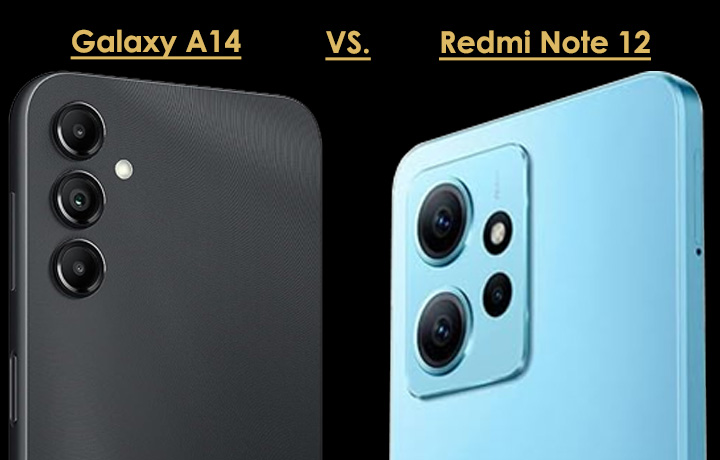Redmi Note 12 vs. Galaxy A14: A Comprehensive Budget Smartphone Showdown
In the ever-evolving landscape of budget smartphones, two contenders, the Redmi Note 12 and the Galaxy A14, stand out with their impressive spec sheets and compelling features.
As consumers seek the perfect balance between performance and affordability, this review aims to dissect every aspect of these devices to determine which one truly deserves the spotlight in the competitive budget smartphone market.
- Related content:
- Infinix GT 10 Pro vs. Redmi Note 10 Pro Max
- Google Pixel 7A vs. Pixel 6A: A Comprehensive Comparison
- Google Pixel 7 Pro Review: A Refreshingly Refined Flagship
Price and Value Proposition:
The price tag plays a crucial role in the purchasing decision of budget-conscious consumers. Here, the Redmi Note 12 takes a strong lead, offering an exceptional value proposition. With the base model equipped with 4GB of RAM and 120GB of storage, priced at approximately 117,000, it clearly outshines the Galaxy A14.
The A14, priced at 116,900, offers similar specifications but comes with only 64GB of storage. To match the Note 12’s storage, one must invest in the more expensive 128GB variant, which is priced at around 126,900.
This pricing strategy gives the Redmi Note 12 a distinct advantage, offering either twice the storage at the same price or a lower price for equivalent storage. Without a doubt, the Redmi Note 12 stands as the winner in terms of value for money.
Design and Build:
While design aesthetics are subjective, the Galaxy A14 manages to capture attention with its textured finish, reminiscent of Samsung’s higher-end models. This design choice lends the A14 a sense of familiarity and appeal. In contrast, the Redmi Note 12 presents a more generic look, potentially missing an opportunity to stand out in terms of design.
Both phones boast a plastic back and glass front, providing a comfortable feel in hand. The A14 is slightly thicker and heavier at 201 grams compared to the Note 12’s 188 grams, offering a different tactile experience. Despite the differences, both phones share fingerprint sensors, dual microphones, and well-placed buttons.
Notably, the Note 12 gains extra points for its faster fingerprint sensor, an IP53 dust and splash-resistant rating, and the inclusion of an IR Blaster. In the design and build category, the Redmi Note 12 takes a slight lead due to its added features and ergonomic build.
Display:
The Redmi Note 12 solidifies its lead with a 120Hz AMOLED display, leaving the Galaxy A14’s 60Hz PLS LCD display in the dust. The Note 12’s smoother display offers a more vibrant and engaging visual experience, making it a preferred choice for media consumption and gaming.
Its AMOLED panel brings deeper blacks, more accurate colors, and higher brightness levels. In comparison, the A14’s display exhibits a slight blue tint and inferior color reproduction. Additionally, the Note 12’s Gorilla Glass 3 protection adds another layer of durability. The display category is a clear win for the Redmi Note 12, offering a superior viewing experience.
Software:
Both the Redmi Note 12 and Galaxy A14 ship with Android 13 and promise two years of major updates, making them equal contenders in software longevity. However, Samsung’s One UI gains an edge due to its reputation for stability and user-friendliness.
The Note 12’s software matches up in terms of updates, but the proven track record of One UI and its stability make the A14 the preferable choice for users valuing a consistent and reliable software experience.
Performance:
In the realm of performance, the Redmi Note 12 emerges as the victor. Its Snapdragon 685 processor outperforms the Galaxy A14’s Exynos 850, as reflected in both benchmarks and real-world usage.
Both phones start with 4GB of RAM, but the Note 12’s capacity can be upgraded to 8GB, providing an edge in multitasking capabilities. The Exynos 850, though improved, falls short of the Snapdragon 685’s prowess, making the Note 12 the undisputed champion for users seeking enhanced performance on a budget.
Camera Quality:
In the camera department, the Redmi Note 12 once again steals the limelight. Although both phones boast triple-camera setups, the Note 12 captures more color-accurate and detailed images. While both devices provide satisfactory results on their own, the Note 12’s camera system showcases better color reproduction and finer details.
The A14’s cameras are by no means subpar, but they fall slightly behind in comparison. Even in the video category, the Note 12 excels with better stabilization, further solidifying its position as the superior camera performer.
Battery Life and Charging:
The Redmi Note 12 continues its domination in the battery realm, offering a 5,000mAh battery and a 33W charger out of the box. The Galaxy A14, on the other hand, comes with a 15W charger that needs to be purchased separately. This advantage in charging speed and convenience further cements the Note 12’s lead in battery-related aspects.
Verdict:
With a commanding score of six points to two, the Redmi Note 12 emerges as the clear winner in this comprehensive comparison. However, choosing between these two budget phones isn’t a simple task. The Galaxy A14 represents the safer and more predictable option, thanks to Samsung’s reputation for software stability.
On the other hand, the Redmi Note 12 offers a compelling package of specifications, performance, and features that cater to users seeking an exceptional experience within a budget-friendly range. While the Galaxy A14 may be the safer choice, the Redmi Note 12 undoubtedly claims the title of the better phone, targeting those who demand superior specifications and performance without breaking the bank.
- Shop On Amazon Using Our Links To Support Us:
- Amazon under $25:
- Amazon best sellers:
- Amazon most gifted:






